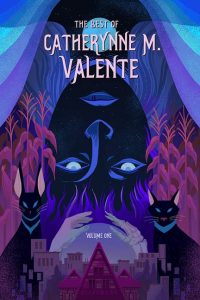Gary K. Wolfe Reviews The Best of Catherynne M. Valente: Volume One by Catherynne M. Valente
 The Best of Catherynne M. Valente: Volume One, Catherynne M. Valente (Subterranean 978-1-64524-077-8, $50.00, 800pp, hc) April 2023.
The Best of Catherynne M. Valente: Volume One, Catherynne M. Valente (Subterranean 978-1-64524-077-8, $50.00, 800pp, hc) April 2023.
In a career of less than two decades, Catherynne M. Valente seems to have made an outsized impact on fantasy and SF, despite never quite fitting in to any movement or trend, and never quite getting predictable – except, perhaps, for her unabashed love of language. For a while, some of her work seemed to align with the New Weird, but then that got less new and Valente got more weird. Her more recent work is among her very best, ranging from the hilarious and heartbreaking (‘‘The Difference Between Love and Time’’) to the playful (Space Opera) to metaphysical mystery (Comfort Me with Apples) to a thoroughly original – and again often funny – postapocalyptic vision (The Past is Red). As with the Peter S. Beagle collection, the massive The Best of Catherynne M. Valente (clocking in at a hefty 800 pages – and this is only Volume One!) – necessarily focuses on short fiction, although it does include stories which provided the germs of larger works, such as ‘‘Palimpsest’’ and ‘‘The Future is Blue’’. Although these 39 stories and six poems are not presented in chronological order, it’s fascinating to watch a fiercely intelligent writer evolve from an early infatuation with almost euphuistic, densely allusive prose to more controlled, compactly structured, and cleanly plotted tales – though that fascination with language is never far from the surface.
Valente is both something of a classicist and something of an experimenter, equally fascinated by world mythologies and pop culture artifacts. She can bring her distinctive style and point of view to tales of werewolves (‘‘The Wolves of Brooklyn’’, zombies (‘‘Days of Flaming Motorcycles’’), zombies and fairies (‘‘A Fall Counts Anywhere’’, one of the funniest selections), vampires (‘‘In the Future When All’s Well’’), even Lovecraftiana (‘‘Down and Out in R’lyeh’’), in every instance interrogating or undermining the traditional conventions of the form. She can revisit a classic myth by presenting Orpheus and an unfortunately dead Eurydice trying to get by in a nice suburb with various other figures from Greek myth as problematical neighbors, in ‘‘L’Esprit de L’Escalier’’. She can reinvent classic fairy tales by dramatically shifting viewpoints, as in ‘‘A Delicate Architecture’’ (‘‘Hansel and Gretel’’) or ‘‘The Red Girl’’ (‘‘Red Riding Hood’’). Her literary sources can be as diverse as Lewis Carroll and J.M. Barrie (‘‘The Flame After the Candle’’), Jorge Luis Borges (‘‘Reading Borges in Buenos Aires’’, a provocative treatment of the city as novel), even Dante, in the odd but appealing combination of detective story and purgatory fantasy ‘‘No One Dies in Nowhere’’.
Valente’s use of narrative forms and conventions is equally eclectic. She’s fond, for example, of the formal device that rhetoricians call anaphora – repeating an initial phrase at the beginning of successive sentences, creating a litany-like rhythm: ‘‘The Sin Eater’’ opens with three paragraphs each beginning ‘‘There is a woman outside of Sheridan’’, a phrase repeated several times again later; the same device shows up in ‘‘Reading Borges in Buenos Aires’’, ‘‘The Consultant’’, and ‘‘Planet Lion’’. Then she will turn to modernist or postmodernist techniques like presenting an entire story as a clickbait-style listicle (‘‘Twenty-Five Facts About Santa Claus’’), or as numbered paragraphs (‘‘One Breath, One Stroke’’), or as a sequence of documents (‘‘A Buyer’s Guide to Maps of Antarctica’’, in which a succession of maps in a catalogue reveals a vicious rivalry between two explorers), or ‘‘Golubash, or Wine-Blood-War-Elegy’’, which presents galactic rivalries through a series of far-future wine-tasting notes). Sometimes such playing with technique suggests a restlessness on Valente’s part, sometimes an almost self-conscious effort to expand her repertoire, and sometimes sheer joy in discovering what she can do with stories. The results, of course, may vary widely from reader to reader, which may be one reason that a Valente story which seems completely immersive to one reader may seem almost impenetrable to another.
It’s also why any two readers are unlikely to come away from The Best of Catherynne M. Valente with the same list of favorites. ‘‘Silently and Very Fast’’, for example, is probably Valente’s most successful early foray into SF, describing how a former house AI, facing new responsibilities, tries to come to grips with the problem of understanding humans, and the family with which it increasingly becomes entwined over generations. But the allusive style, opening with bits of Sumerian mythology, may seem to mask the provocative SF content for some readers. Of more recent stories, my favorites include ‘‘The Future is Blue’’ with its bleak setting but the blithely chipper voice and indefatigable attitude of Tetley Abednego; ‘‘Color, Heat, and the Wreck of the Argo’’, a distinctively original take on the idea of the magic camera (in this case an antiquated video recorder); ‘‘L’Esprit D’Escalier’’, the Orpheus tale mentioned earlier, and ‘‘The Difference Between Love and Time’’, in which Valente’s fondness for narrative hopscotching perfectly reflects the narrator’s lifelong affair with ‘‘the space/time continuum,’’ which takes on many personae; impressively, the tale retains its intimate focus by returning to memories of vacations in a seedy Washington state resort. While Valente’s contagious passion for language seems unabated in these recent works, it also seems more fully under control, as though she’s learned to trust the tale itself – and the best of those tales are true gems.
Gary K. Wolfe is Emeritus Professor of Humanities at Roosevelt University and a reviewer for Locus magazine since 1991. His reviews have been collected in Soundings (BSFA Award 2006; Hugo nominee), Bearings (Hugo nominee 2011), and Sightings (2011), and his Evaporating Genres: Essays on Fantastic Literature (Wesleyan) received the Locus Award in 2012. Earlier books include The Known and the Unknown: The Iconography of Science Fiction (Eaton Award, 1981), Harlan Ellison: The Edge of Forever (with Ellen Weil, 2002), and David Lindsay (1982). For the Library of America, he edited American Science Fiction: Nine Classic Novels of the 1950s in 2012, with a similar set for the 1960s forthcoming. He has received the Pilgrim Award from the Science Fiction Research Association, the Distinguished Scholarship Award from the International Association for the Fantastic in the Arts, and a Special World Fantasy Award for criticism. His 24-lecture series How Great Science Fiction Works appeared from The Great Courses in 2016. He has received six Hugo nominations, two for his reviews collections and four for The Coode Street Podcast, which he has co-hosted with Jonathan Strahan for more than 300 episodes. He lives in Chicago.
This review and more like it in the March 2023 issue of Locus.
 While you are here, please take a moment to support Locus with a one-time or recurring donation. We rely on reader donations to keep the magazine and site going, and would like to keep the site paywall free, but WE NEED YOUR FINANCIAL SUPPORT to continue quality coverage of the science fiction and fantasy field.
While you are here, please take a moment to support Locus with a one-time or recurring donation. We rely on reader donations to keep the magazine and site going, and would like to keep the site paywall free, but WE NEED YOUR FINANCIAL SUPPORT to continue quality coverage of the science fiction and fantasy field.
©Locus Magazine. Copyrighted material may not be republished without permission of LSFF.







